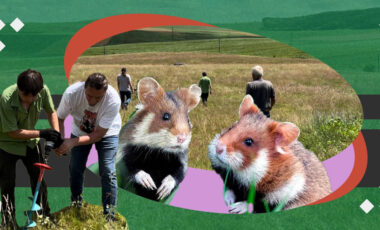Nature park in Odesa region rescues 55 red-listed newts washed away by flood caused by Kakhovka dam destruction

Photo: Ministry of Environmental Protection and Natural Resources of Ukraine
In one day, the Tuzly Lagoons National Nature Park saved 55 newts, listed in the Red Book of Ukraine.
Rubryka reports, citing Ukraine's Ministry of Environmental Protection and Natural Resources.
The ministry said that newts were carried to the Black Sea coast with the Dnieper waters. It was there that the workers of the park found them. As reported, 149 animals were found dead.
According to the estimates, these newts are the Danube crested newts (Triturus dobrogicus), found in central and eastern Europe, along the Danube river basin and some of its tributaries, and in the Dnipro River delta in Ukraine's southern Kherson region, which was recently flooded by the flow of water from the Kakhovka Reservoir after Russian forces blew up the Kakhovka hydroelectric plant and dam.
The ministry stressed that newts do not live in salt water. Rescued animals were taken to the Danube Biosphere Reserve, where they were released in different sections of the river (tributaries). Displaced animals went through the travel successfully. According to experts, they should adapt well to the Danube waters.
"The forces of all environmentalists today are focused on eliminating the consequences of the biggest environmental disaster that Russia has caused since the beginning of its full-scale invasion of Ukraine," the ministry said. "We continue documenting and calculating the environmental damage caused by the Russian terrorist attack on the Kakhovka Hydroelectric Power Plant. The enemy must answer for every victim of the war they started!"
Doctor Ivan Rusiev, the director of the Tuzly Lagoons Park, said the employees recorded the first live and dead animals from the Dnipro River on June 12. He stressed these animals do not live in the Tuzly Lagoons park, but the inspection of the Black Sea coast by national park workers in some areas showed that there are many animals and, unfortunately, mostly dead. There are also frogs of various species.
"Those newts or frogs that were still alive immediately became food for martin birds, cormorants, herons, and terrestrial predatory mammals. The number of those thrown onto the shore of the sea within our park can be counted in the tens of thousands," he said. "We did not find any other species of animals. Water on the sea coast is now very desalinated by Dnipro water. We will continue monitoring and report what happens on the coast in other areas."
How has Ukraine's environment been affected so war by the Kakhovka hydroelectric plant destruction?
As Rubryka reported, on the night of June 6, Russian invaders blew up the Kakhovka hydroelectric power plant, located a few kilometers from the temporarily occupied city of Nova Kakhovka, Kherson region.
Ukraine's environmental minister Ruslan Strilets said 160,000 birds and more than 20,000 wild animals are at risk of death due to the Russians undermining the dam.
Rubryka also reported that the Kazkova Dibrova Zoo, with more than 300 animals, was flooded in Nova Kakhovka. Only some animals were saved.
The recent disaster may lead to the destruction of the population of the Falz-Fein Stylodipus, which lives in Europe's biggest desert, the Oleshky Sands, according to wildlife conservation expert Oleh Lystopad.
According to the estimates of the Minister of Agrarian Policy and Food of Ukraine Mykola Solskyi, farmers will not be able to fully use 1-1.5 million hectares of agricultural land due to the explosion of the Kakhovka plant.
As Rubryka reported, animal rights activists staged a "Russia has drowned us" demonstration in the city of Augsburg in the Federal Republic of Germany.

Meest launches free feed delivery for rescued animals in Kherson region

Seals and dolphins in captivity: is it possible to return animals from dolphinariums to the sea in Ukraine?

Ukraine's southern regions ban fishing as mass fish deaths occur caused by Kakhovka dam destruction






















































